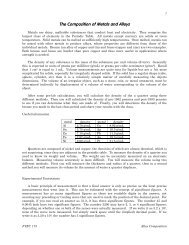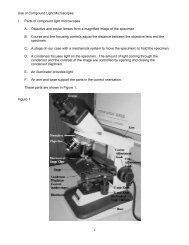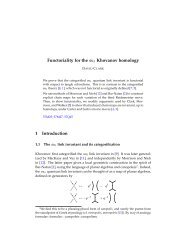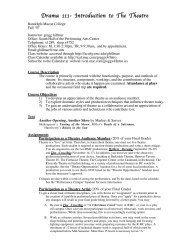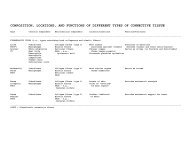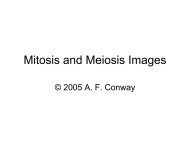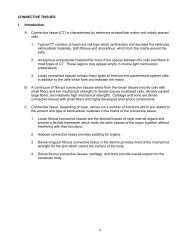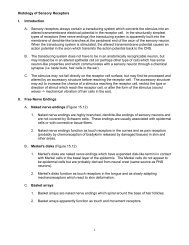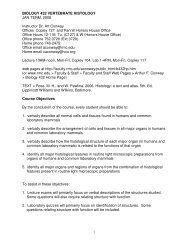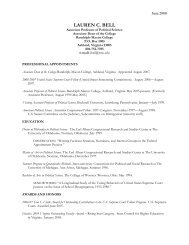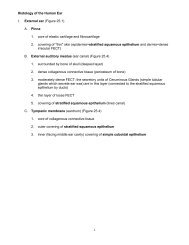HISTOLOGY OF THE DIGESTIVE SYSTEM I ... - Faculty.rmc.edu
HISTOLOGY OF THE DIGESTIVE SYSTEM I ... - Faculty.rmc.edu
HISTOLOGY OF THE DIGESTIVE SYSTEM I ... - Faculty.rmc.edu
Create successful ePaper yourself
Turn your PDF publications into a flip-book with our unique Google optimized e-Paper software.
D. Stomach (Figure 17.5 - 17.16, Plate 51, 52, 54)<br />
1. Mucosa<br />
a. Epithelium<br />
(1) Mainly simple columnar; may be pseudostratified columnar in regions<br />
containing some types of enterochromaffin (APUD) cells (unicellular endocrine<br />
glandular epithelium)<br />
(2) Most cells of the lumen lining are mucous- secreting so the lining epithelium<br />
may be called a sheet gland<br />
(3) Enterochromaffin cells (or APUD cells) are small with basally located light<br />
cytoplasm and dark nuclei. At least some of these cells extend a sensory<br />
process to the luminal surface. Some may have acidophilic granules at the<br />
basal end.<br />
b. Lamina propria - loose FECT<br />
c. Muscularis mucosae - inner circular and outer longitudinal smooth muscle layers,<br />
frequently in bundles<br />
d. Other features<br />
(1) The mucosa forms longitudinal folds or rugae.<br />
(2) The mucosa contains gastric glands (simple tubular glands) which are referred<br />
to as cardiac glands, fundic glands, or pyloric glands based on the gland<br />
structure and the region of the stomach in which the gland is normally found.<br />
Pure cardiac and pyloric glands would contain only mucus-secreting cells plus<br />
occasional enterochromaffin cells while fundic glands contain multiple exocrine<br />
cell types.<br />
(a) Cardiac glands are branched tubular glands which occur in a narrow zone<br />
near the esophageal-stomach junction. They are usually shorter and less<br />
coiled than pyloric glands.<br />
(b) Pyloric glands are located near the pyloric region of the stomach. These<br />
branched tubular glands are usually longer and more highly coiled than<br />
cardiac glands.<br />
(c) Fundic glands occur throughout most of the stomach. These branched<br />
tubular glands contain three exocrine cell types plus numerous solitary<br />
endocrine cells.<br />
[1] Exocrine cell types<br />
[a] Chief cells (or zymogenic or peptic cells) (Figure 17.8, 17.9)<br />
- relatively columnar cells with basal nuclei, basophilic basal<br />
cytoplasm and acidophilic apical cytoplasm containing<br />
acidophilic secretory granules<br />
- serous secretory cells which secrete pepsinogen<br />
- located in the deeper 1/3 of the glands<br />
6



